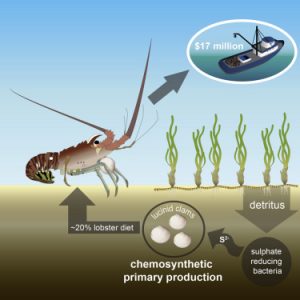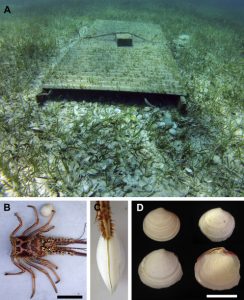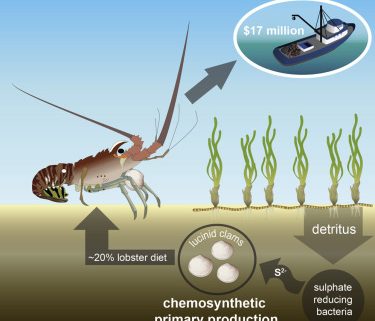Caribbean Spiny Lobster Fishery Is Underpinned by Trophic Subsidies from Chemosynthetic Primary Production
By Molly Rickles, SRC intern
Caribbean spiny lobsters are a very commercially important species that brings in millions of dollars in revenue annually. The lobsters are especially important to the Bahamas, which has a large fishery. Recently, artificial reefs were created for the lobsters in areas where they are usually fished. This made it easier for the present study from Higgs and colleagues to take place, which analyzed the Caribbean spiny lobster diet. The main purpose of the study was to show that a significant portion of the lobster’s diet is from chemosynthetic primary production in the form of lucinid clams, which are found on artificial reefs. (Figure 1).

Figure 1: This image shows that the Caribbean spiny lobster trade is very lucrative, especially in the Bahamas. It also shows the food web and how the lobsters obtain their food from chemiosynthetic primary production. The lobsters consume the clams, which obtain nutrients from sulfate that was fixed by sulfate fixing bacteria from detritus. (Higgs, N. D., Newton, J., & Attrill, M. J. (2016). Caribbean Spiny Lobster Fishery Is Underpinned by Trophic Subsidies from Chemosynthetic Primary Production. Current Biology, 26(24), 3393-3398. doi:10.1016/j.cub.2016.10.034)
Researchers sampled 160 lobsters from both natural and artificial reefs. Tissue samples were collected from the tail muscle of the lobsters and dietary tissue samples required the whole lobster. (Figure 2) To study the lobster’s diet, scientists used stable isotope analysis to organize the lobster’s diets into five main food groups. Through this approach, it was found that the phototrophic group, or autotrophs, made up the majority of the lobster’s diet. These results show that chemosynthetic primary productivity plays an important role in commercial fisheries since the lobsters are mainly dependent on phototrophic productivity for food. The results also show that 1/5 of the lobster’s diet is from the chemosynthetic primary productivity of lucinid clams, which are found on artificial reefs in the lobster’s habitat. The clam’s productivity is from the chemoautotroph organisms that live symbiotically with them. In addition to studying the diet, the researchers compared the diets of lobsters living on natural reefs against lobsters that lived on artificial reefs. It was found that lobsters living on natural reefs have higher values of chemosynthetic productivity in their diets. This is mainly due to the fact that natural reefs have denser sea grass, which allows for higher chemosynthetic productivity.

Figure 2: This figure shows how the study was carried out. The top picture is of an artificial lobster shelter, which is where the lobsters used in this study normally were found. Image B is the carapace of a lobster used in the study. Image C is of a lobster dactylus, the last appendage of the lobster’s thorax. Image D shows lucinid clams, which the lobsters mainly feed on. (Higgs, N. D., Newton, J., & Attrill, M. J. (2016). Caribbean Spiny Lobster Fishery Is Underpinned by Trophic Subsidies from Chemosynthetic Primary Production. Current Biology, 26(24), 3393-3398. doi:10.1016/j.cub.2016.10.034)
This study is important because it was the first to determine the diet of the Caribbean spiny lobster. Since this species is heavily fished, this study showed the importance of spiny lobster management to maintain its population. It is also important to maintain chemosynthetic production on the artificial reefs to maintain a food source for the lobsters. This study also outlined the importance of the spiny lobster in marine ecosystems, since it was shown that the lobsters play an important role in transferring chemosynthetically fixed carbon from deep sediment to the organisms in the ecosystem. Since lobsters are both economically and ecologically important species, it is vital to protect and manage their population so that they can continue to contribute to the human diet and marine ecosystem.
Works cited
Higgs, N. D., Newton, J., & Attrill, M. J. (2016). Caribbean Spiny Lobster Fishery Is Underpinned by Trophic Subsidies from Chemosynthetic Primary Production. Current Biology, 26(24), 3393-3398. doi:10.1016/j.cub.2016.10.034




Leave a Reply
Want to join the discussion?Feel free to contribute!